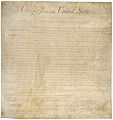Tenth Amendment to the United States Constitution facts for kids
The Tenth Amendment is an important part of the U.S. Constitution. It's found in the Bill of Rights, which was added on December 15, 1791. This amendment helps explain federalism. Federalism is how power is shared between the national (federal) government and the individual state governments. The Tenth Amendment makes it clear that any powers not given to the federal government by the Constitution belong to the states or to the people.
Contents
What is the Tenth Amendment?
The Tenth Amendment states: "The powers not delegated to the United States by the Constitution, nor prohibited by it to the states, are reserved to the states respectively, or to the people."
This means that the U.S. government (the "United States") only has the powers that the Constitution specifically gives it. If a power isn't given to the federal government, and it's not forbidden for the states to have, then that power belongs to the states or to the people.
Why is it important?
The main goal of the Tenth Amendment was to show how power is balanced between the federal government and the state governments. When the Constitution was first created, some people worried that the new national government might become too strong. They feared it would take too much power away from the states.
The Tenth Amendment was added to calm these fears. It made it clear that states still have many important powers. It helps make sure that states can manage their own local issues. This includes things like local laws, education, and public safety.
Real-life example: Bond v. United States
A good way to understand the Tenth Amendment is by looking at a real court case. In 2011, there was a case called Bond v. United States. A woman named Carol A. Bond was accused of using a chemical substance in a local dispute. She was charged under a federal law called the Chemical Weapons Implementation Act of 1998.
Bond's lawyers argued that this federal law was meant for serious international issues, like terrorism or dangerous countries. They believed her actions should have been handled by state law, not federal law.
The Supreme Court looked at the case. They decided that Bond had the right to argue that the federal law was interfering with powers that should belong to the states. The Court sent the case back to a lower court to be re-examined. This case showed how the Tenth Amendment helps protect the balance of power between federal and state governments.
Images for kids
-
The Bill of Rights in the National Archives
See also
 In Spanish: Décima Enmienda a la Constitución de los Estados Unidos para niños
In Spanish: Décima Enmienda a la Constitución de los Estados Unidos para niños


